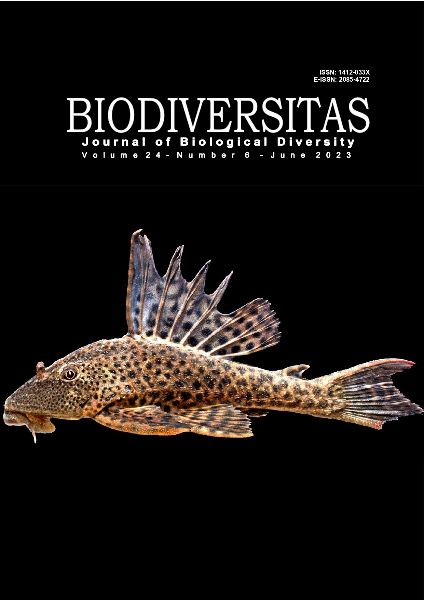Diversity of insect carried-fungi in chili (Capsicum annuum) crop at Banyumas District, Central Java Province, Indonesia
##plugins.themes.bootstrap3.article.main##
Abstract
Abstract. Suroto A, Mugiastuti E, Tarjoko, Oktaviani E, Bahrudin M. 2023. Diversity of insect carried-fungi in chili (Capsicum annuum) crop at Banyumas District, Central Java Province, Indonesia. Biodiversitas 24: 3394-3406. This study aimed to determine the species of fungal pathogens that have the potency to be carried by various insects in endemic areas of chili (Capsicum annuum L.) disease and locations with high populations of chili insect vectors in the Banyumas District. The insect samples were collected from three chili planting locations in Banyumas District (Karanglewas, Sumbang, and Sokaraja Sub-districts) from March to November 2022. The following methods carried out the research: (i) determining the sampling location, (ii) insect sampling and identification, (iii) isolation and purification of fungal pathogen carried by insects, (iv) pathogenicity test, (v) identification of fungal pathogens based on morphology characters. The exploration of 13 villages in 3 (three) sub-districts of Banyumas District found 60 insects collected from healthy and diseased chili plants. Totally, six genera of fungi were isolated and identified, namely Fusarium, Pythium, Curvularia, Penicillium, Geotrichum, and Phytophthora. This is preliminary research on the interaction between plants, microbes, and insects. Understanding these aspects is essential, not only from an ecological perspective but also for improving the genetic quality of crops as well as for integrated pest management.
##plugins.themes.bootstrap3.article.details##
Most read articles by the same author(s)
- LOEKAS SOESANTO, ANNISA RAHMADDILA RIZKY HARTONO, ENDANG MUGIASTUTI, HERI WIDARTA, Seed-borne pathogenic fungi on some soybean varieties , Biodiversitas Journal of Biological Diversity: Vol. 21 No. 9 (2020)
- ENDANG MUGIASTUTI, SUPRAYOGI, NUR PRIHATININGSIH, LOEKAS SOESANTO , Short Communication: Isolation and characterization of the endophytic bacteria, and their potential as maize diseases control , Biodiversitas Journal of Biological Diversity: Vol. 21 No. 5 (2020)
- LOEKAS SOESANTO, BISIRIL FATIHAH, ABDUL MANAN, ENDANG MUGIASTUTI, NUR PRIHATININGSIH , Organic control of Bemisia tabaci Genn. on Capsicum annuum with entomopathogenic fungi raw secondary metabolites , Biodiversitas Journal of Biological Diversity: Vol. 21 No. 12 (2020)
- LOEKAS SOESANTO, ENDANG MUGIASTUTI, ABDUL MANAN, The use of alternative liquid media for propagation of pathogenic fungi and their effect on weeds , Biodiversitas Journal of Biological Diversity: Vol. 22 No. 2 (2021)
- LOEKAS SOESANTO, RISMA ARSI SUSANTI, ENDANG MUGIASTUTI, ABDUL MANAN, MURTI WISNU RAGIL SASTYAWAN, JOKO MARYANTO, Remediation of chlorpyrifos-contaminated soils by crude secondary metabolites of Trichoderma harzianum T213 and its effect on maize growth , Biodiversitas Journal of Biological Diversity: Vol. 23 No. 5 (2022)
- ENDANG MUGIASTUTI, ABDUL MANAN, LOEKAS SOESANTO, Biological control of maize downy mildew with the antagonistic bacterial consortium , Biodiversitas Journal of Biological Diversity: Vol. 24 No. 9 (2023)
- LOEKAS SOESANTO, DHIMAS AULI SAPUTRA, MURTI WISNU RAGIL SASTYAWAN, ENDANG MUGIASTUTI, AGUS SUPRAPTO, RUTH FETI RAHAYUNIATI, Secondary metabolites of the granular form of Pseudomonas fluorescens P60 and its applications to control tomato bacterial wilt , Biodiversitas Journal of Biological Diversity: Vol. 24 No. 4 (2023)
- PURWANTO, EKA OKTAVIANI, NI WAYAN ANIK LEANA, Isolation and molecular identification of halotolerant diazotrophic bacteria from The Northern Coastal of Pemalang, Central Java, Indonesia , Biodiversitas Journal of Biological Diversity: Vol. 23 No. 11 (2022)
- RUTH FETI RAHAYUNIATI, RULY EKO KUSUMA KURNIAWAN, ENDANG MUGIASTUTI, Distribution of banana Fusarium wilt in Banyumas, Indonesia, and characterization of F. oxysporum isolates from infected bananas and taro growing on the same farm , Biodiversitas Journal of Biological Diversity: Vol. 25 No. 4 (2024)
- SUPRAYOGI, PRITA SARI DEWI, EKA OKTAVIANI, ALWA WIDI AISYA, Marker validation for salt tolerance in Indica rice , Biodiversitas Journal of Biological Diversity: Vol. 23 No. 9 (2022)

